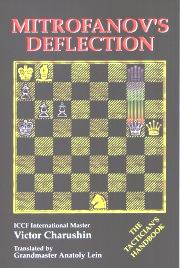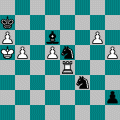Mitrofanov anticipated - and not quite rehabilitated
One of the most beautiful endgame studies ever composed is Mitrofanov's
famous 'Rustaveli-study' of 1967, better known as 'the study with Qg5'.
It would be my candidate for 'study of the millennium'. The jury of the
Rustaveli-tourney, which included Mikhail Tal, chose it from among 250
entries. The report said: 'It doesn't look like any other, and is beyond
the rest of the rest of the studies.' Herbstmann, also a member of the
jury, said: 'Immediately after the first preview, Mitrofanov's masterpiece
created a tremendous impression by the intensity and novelty of the idea.
The ranking of the other studies was designated by us beginning with the
second place.'
There has, however, almost from the beginning, been
a cloud over this study. And very recently, a second cloud appeared.
But first the study itself.
L. Mitrofanov 1st Prize Rustaveli-tourney, 1967 |
 1.b6+ A blockade of the Queen's side pawns by Bc7+ must be prevented.
1...Ka8 2.Re1! And while it is still possible, even if it costs a Rook,
the bottom rank must be closed against checks from a Queen that will appear on h1.
2...Nxe1 3.g7 h1Q (3...Nc4+ 4.Kb5 h1Q 5.g8Q+ Bb8 6.a7 Na3+ 7.Kc6
Qh2 8.axb8Q+ Qxb8 9.b7+ Ka7 10.Qg1+ Ka6 11.Qb6 mate) 4.g8Q+ Bb8 5.a7
Nc6+ 6.dxc6 Qxh5+ Now how to stop the checks that Black has
anyway? After 7.Ka6 Qe2+ or 7.Kb4 Qh4+ they will go on. The move White
plays now is the heart of the study, and of a recent book about similar
moves.
1.b6+ A blockade of the Queen's side pawns by Bc7+ must be prevented.
1...Ka8 2.Re1! And while it is still possible, even if it costs a Rook,
the bottom rank must be closed against checks from a Queen that will appear on h1.
2...Nxe1 3.g7 h1Q (3...Nc4+ 4.Kb5 h1Q 5.g8Q+ Bb8 6.a7 Na3+ 7.Kc6
Qh2 8.axb8Q+ Qxb8 9.b7+ Ka7 10.Qg1+ Ka6 11.Qb6 mate) 4.g8Q+ Bb8 5.a7
Nc6+ 6.dxc6 Qxh5+ Now how to stop the checks that Black has
anyway? After 7.Ka6 Qe2+ or 7.Kb4 Qh4+ they will go on. The move White
plays now is the heart of the study, and of a recent book about similar
moves.
7.Qg5!! 'A move from another world,' as Charushin, the
writer of that book, puts it. Only this utterly unlikely move wins. White
lifts his mating threat, the pin of Bb8, lets his Queen be captured with
check on an unguarded square, remains with a few pawns against Queen, Bishop
and Knight—and wins. The point is geometrical: after the forced 7...Qxg5+
8.Ka6 the Queen is deflected from the white diagonal where she could
give check, and the board is one rank too short for her to reach a white
square anyway; if Black could play Qg0+, he would be saved. But there is
no 0th rank, and White still threatens mate. 8...Bxa7 Or 8...Qb5+
9.Kxb5 Nc2 10.c7 and wins. (See diagram.)
9.c7! With only two pawns against an overwhelming majority, a
silent move.The double threat c8Q+ and b7 mate forces Black to give the
Queen. 9...Qa5+ 10.Kxa5 Kb7 11.bxa7 and White wins.
We could wish that were all.
But in many books, including Charushin's, and even
Mitrofanov's own 'Deceptive
Simplicity', the study is given with the Rook sacrifice (2.Re1 Nxe1) amputated
(see diagram); that is, without a white Rook, and with the Nf3 on
e1 already.
The sad reason is that in 1970, soon after its triumphant
appearance, the Soviet master Alexander Kuindzhi found a nasty refutation
of the
masterpiece. After 1.b6+ Ka8 2.Re1, instead of taking the Rook, he let
Black continue with 2...Nc4+ There follows: 3.Kb5 Nxb6 4.Kxb6 (or 4.g7
Ka7 5.g8Q Nd4+ 6.Ka5 Nc4+ 7.Ka4 Nb6+
with a miraculous perpetual) 4...Nxe1 5.g7 h1Q 6.g8Q+ Bb8 7.Qg7 (see
diagram) and all seems well (7...Qxd5 8.Qb7+ Qxb7+ 9.axb7 with a nice
single-pawn mate) but Black has: 7...Qg1+! 8.Qxg1 Ba7+ and it is a draw.
But apart from this amputated version, you will
also sometimes see an amended one with the Rook on e1, but with
the Nf3 on g2, which undoes the perpetual. This is so much better than
that amputated version, without the Rook sacrifice, and the passive Ne1,
that one wonders what is wrong with it. Neither Harold van der Heijden,
the Dutch study-guru, nor I have been able to discover any fault in the
Ng2-version, either on the board or in literature. It's a mystery that
even Mitrofanov himself preferred the version without the Rook-sacrifice.
Then, in September 1999, when I wrote about Charushin's and Mitrofanov's
books in my chess column in the Dutch AD-Magazine, shivers ran down my
spine when a former Dutch champion,
Rini Kuijf, mailed me to say that after 1.b6+ Ka8 2.Re1 Nc4+ 3.Kb5 Nxb6
4.g7 Ka7 (see diagram) in Kuindzhi's refutation, White, instead
of 5.g8Q, of course plays 5.Kc6! and wins after all.
Mitrofanov rehabilitated! I could almost see the
headlines: REFUTATION OF FAMOUS
Qg5-STUDY REFUTED!
Kuijf's main variation was: 5...Bb4 6.g8Q Nd4+
7.Kc7 Nb5+ 8.Kd8 Bxe1 9.Qg7+ Kxa6 10.Qa1+ Ba5 11.Qh1 (see diagram)
and White might be able to negotiate his h-pawn to Queen. And if he isn't,
he wins a piece for it, reaching an endgame of Q vs. B+N or Q vs. 2B which
is, according to the latest database-insights, winning.
If only Mitrofanov could have known—but he had died in
1992. In any case, all those sadly truncated publications of the great
work, together with the Ng2-ones, could be thrown away: the Qg5-study was
restored to its initial splendor.
But the genius hadn't run out of his bad luck yet. When I mailed this
sensational discovery to Harold van der Heijden, he answered almost immediately
that Kuijf's refutation of Kuindzhi's refutation was an interesting try,
but that he had found an improbable move which refuted it. After
Mitrofanov's 1.b6+ Ka8 2.Re1, Kuindzhi's 2...Nc4+ 3.Kb5 Nxb6 4.g7 Ka7 and
Kuijf's 5.Kc6, (see diagram) Van der Heijden plays the incredible
5...Be7!!
It's a move nobody would ever find in a game; worthy
of a study in itself. Instead of capturing a Rook, Black puts a Bishop
en prise, with check, on an unguarded square. The point is that
by capturing it, the Rook would be lured away from where it defends against
Black's promotion, and that Black himself now threatens Nd4+ and Nb5+ with
a new version of Kuindzhi's perpetual. So: White has to play 6.Rxe7+ (Rb1
or Rd1 are countered by Nd4+) Kxa6 and now White has three tries, each
of which misses the win by a hair.
a) 7.Ra7+ Kxa7 8.g8Q On h1Q White would now mate
with 9.Qh7+ Ka6 10.Qd3+ Ka7 11.Qa3+ Kb8 12.Qd6+, but with the Zwischenschach
8...Nd4+ Black spoils this.
b) 7.Re1 This nice switchback sacrifice almost wins,
too: 7...Nxe1 8.g8Q h1Q 9.Qf7 (or Qd8) Qxd5+ 10.Qxd5 Nxd5 11.Kxd5 Nf3 12.h6
Ng5 with a theoretical draw.
c) 7.g8Q Nd4+ (Not 7...h1Q 8.Ra7+ and White mates) 8.Kc5 h1Q 9.Kxd4 and
now Qa1+ puts the crown on the bad luck; the Rook is lost, and White must
settle for 10.Ke4 Qe1+ 11.Kf5 Qxe7 (see diagram)
In a game, White would have some practical chances
here. But 'against best play', it must be a draw, and Mitrofanov's Qg5-study
remains refuted.
PS 8 January 2008: An even straighter way to the draw in the above variation c) is, as one JMRW writes, 10...Qh1+! 11.Ke5 (11.Kf5 Qxh5+ 12.Qg5 Qxg5+ 13.Kxg5 Nxd5 =) 11...Qh2+! (Qxh5+ 12.Kd6) and now White has to choose from three bad things: repetition; the loss of both of his pawns as after 11.Kf5; or the loss of his Rook with check, e.g. 12.Kf6 Qh4+ 13.Kg7 Qxe7+ 14.Kh6 Qf6+ 15.Kh7 Qe7+ 16.Qg7 Nxd5 17.Qxe7 Nxe7, all resulting in a draw.
The other cloud was discovered recently by, again, Harold van der Heijden,
when he unearthed the following old study.
White to play and win P. Farago Revista Romana de Sah 1936 |
The relevant variation is: 1.g7 Qh5+ 2.Qg5!! (This would also be the answer to 1...Qd8.) Same move, same motivation, 31 years before Mitrofanov; Farago discovered Qg5 first. The Queen is deflected from the white squares, enabling the white King to cooperate in the mate: 2...Qxg5+ 3.Ka6 g1Q 4.g8Q+ Qxg8 5.b7+ Kb8 6.Be5 mate
Before we turn to the question of Mitrofanov's originality: everything that is light, elegant, enjoyable in his study, is clumsy and cumbersome here. Farago's study is also grossly incorrect. To begin with, both Rini Kuijf and another reader, Jef Kaan, told me their computers had told them that 1.Ka6 is an extra solution; White mates in 13. Further, in the main variation, 3...Qb5+ or Qa5+ postpones the mate for some 10 moves. Not to speak of a tree of at least 200 moves in over 20 variations that is needed (mistakenly, too) to prove that only 1.g7 works.
The two studies cannot be compared.
But the fact is there: Farago found Qg5 first. What to make of that?
Herbstmann, with his novelty of the idea, the jury with its it doesn't look like any other, were mistaken. If they had known they might, unless Mitrofanov had humbly added: "After Farago", not have awarded the first prize to his study.
My guess is that Mitrofanov simply didn't know Farago's study. It has, until now, apart from its original publication in Revista Romana de Sah, probably only appeared in Farago's own collection of his studies, "Idei noi in Sahul Artistic" from 1956. Farago was a well-known composer in those years, but the book was in Rumanian. I don't think Mitrofanov would have seen it. And if he did, he would have turned the page as soon as he saw that ugly diagram.
This is a case of 'anticipation'; somebody has an idea that somebody else has had before. The term is not meant to be a eufemism for plagiarism; such things happen. Mitrofanov's many brilliant studies prove he was more than capable of inventing Qg5 himself. I would even go so far as to say that if Mitrofanov did see Farago's Qg5 before he composed his Rustaveli-study, he was still justified in using it as his own, the way a great artist is justified in using an idea a lesser one has bungled.
But I don't think it happened that way, and in any case: Mitrofanov deserves our full admiration for Qg5.
LEOPOLD MITROFANOV composed a few hundred beautiful endgame studies,
forty of which won first prizes. Many have the same kind of romantic, witty
harmony that is characteristic of the Qg5-study.
He was a chemical engineer by profession. Genna
Sosonko remembers him from the Leningrad Chessclub of the sixties; a little
scrag of a man, hardly five feet tall—his growth had been stunted by severe
malnutrition during the WWII siege of Leningrad. He died in 1992 at the
age of 60.
|
|

|
© Tim Krabbé, 1999
With special thanks to Alexander Kuindzhi and Harold van der Heijden.